View in other NatureServe Network Field Guides
NatureServe
Montana
Utah
Wyoming
Idaho
Wisconsin
British Columbia
South Carolina
Yukon
California
New York
Bitterroot Bladderpod - Physaria humilis
Other Names:
Lesquerella humilis
State Rank Reason (see State Rank above)
Montana endemic restricted to a very small area of the Bitterroot Mountains with only a few known occurrences. All occurrences are in the Selway-Bitterroot Wilderness. However, activity related to hiking trails and a lookout tower may adversely impact P. humilis plants or its habitat.
- Details on Status Ranking and Review
Population Size
Score2 - Small: Generally 2,000-10,000 individuals.
Range Extent
Score3 - Local Endemic or Very Small Montana Range: Generally restricted to an area <10,000 sq. miles (equivalent to the combined area of Phillips and Valley Counties) or <6 Sub-basins (4th code watersheds) Range-wide OR limited to one Sub-basin in Montana
Area of Occupancy
Score3 - Very Low: Generally occurring in 3 or fewer Subwatersheds (6th Code HUC’s).
Environmental Specificity
Score1-2 - Moderate to High.
CommentAlpine species whose habitat does not appear to be highly restricted, but may need specific geologic or edaphic conditions of limited distribution.
Trends
ScoreNA - Rank factor not assessed.
CommentTrends are unknown, though there is no indication that the species' has experienced significant declines in Montana and the habitat is stable.
Threats
Score2 - High: 31-70% of the populations are being negatively impacted or are likely to be impacted by one or more activities or agents, which are expected to result in decreased populations and/or habitat quality and/or quantity.
CommentTrampling from recreational activity, activity related to fire lookout tower.
Intrinsic Vulnerability
Score1 - Moderate Vulnerability: Specific biological attributes, unusual life history characteristics or limited reproductive potential makes the species susceptible to extirpation from stochastic events or other adverse impacts to its habitat and slow to recover.
Raw Conservation Status Score
Score
12 to 13 total points scored out of a possible 19.
General Description
Bitterroot Bladderpod is a small, low perennial with 1 to several unbranched stems that are 2-5 cm long and arising from a simple taproot covered with old leaf bases. The basal leaves are 2-5 cm long and have entire-margined, ovate or elliptic blades and a long, narrow petiole. The 3-6 stem leaves are spoon-shaped and 3-7 mm long. The herbage is silvery with a dense covering of appressed, branched hairs. The small, terminal inflorescence is 3-5 flowered, and the four yellow petals are 7-9 mm long. The compressed fruits, or siliques are 3-4 mm long, and wider than they are long.
Phenology
Flowering in late June-August, fruiting in July-August.
Diagnostic Characteristics
Physaria humilis could be confused with Physaria geyeri, as well with as other members of the genus. The alpine habitat is probably the best distinguishing character. Physaria humilis can be distinguished from other alpine species in the mustard family by the compressed fruits that are wider than they are long.
Species Range
Montana Range
Range Descriptions
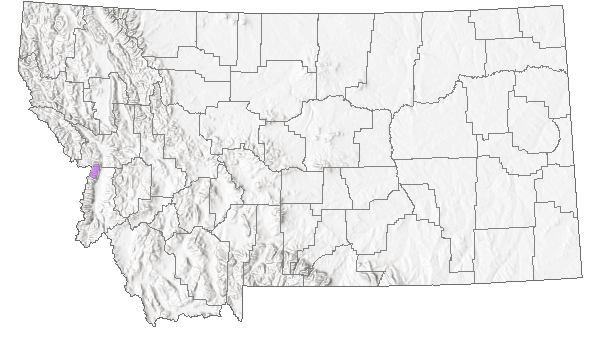
 Native
Native
Range Comments
Endemic to Ravalli County, Montana.
Observations in Montana Natural Heritage Program Database
Number of Observations: 16
(Click on the following maps and charts to see full sized version)
Map Help and Descriptions
Relative Density
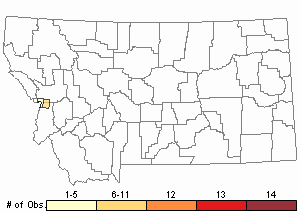
Recency
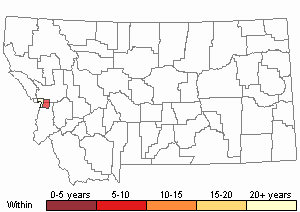
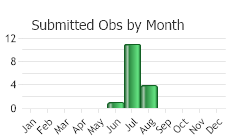
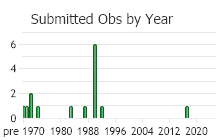
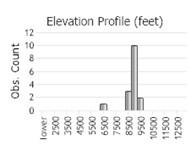 (Observations spanning multiple months or years are excluded from time charts)
(Observations spanning multiple months or years are excluded from time charts)
Habitat
Rocky, granite-derived soil on open slopes, primarily in the subalpine and alpine zones.
National Vegetation Classification System Groups Associated with this Species
Alpine
Alpine - Sparse and Barren
Alpine - Vegetated
Forest and Woodland
Montane - Subalpine Forest and Woodland
Stewardship Responsibility
Threats or Limiting Factors
STATE THREAT SCORE REASON
Reported threats to Montana's populations of Bitterroot Bladderpod are from recreation activity at some populations (MTNHP Threat Assessment 2021). Trampling from hikers inflicts negative impacts, and populations located at a recreation area and along trails are at risk of damage or destruction during maintenance of these. Some damage has occurred at recreation locations, where a proposal is pending to relocate an outhouse. Livestock trampling is suspected to have additional impacts, but related severity is unknown.
References
- Literature Cited AboveLegend:
 View Online Publication
View Online Publication MTNHP Threat Assessment. 2021. State Threat Score Assignment and Assessment of Reported Threats from 2006 to 2021 for State-listed Vascular Plants. Botany Program, Montana Natural Heritage Program, Helena, Montana.
MTNHP Threat Assessment. 2021. State Threat Score Assignment and Assessment of Reported Threats from 2006 to 2021 for State-listed Vascular Plants. Botany Program, Montana Natural Heritage Program, Helena, Montana.
- Additional ReferencesLegend:
 View Online Publication
View Online Publication
Do you know of a citation we're missing? Achuff, P.L. and J.S. Shelly. 1990. Report on the conservation status of Lesquerella humilis, a candidate threatened species. Unpublished report to the U.S. Fish and Wildlife Service. Montana Natural Heritage Program, Helena, Montana. 37 pp.
Achuff, P.L. and J.S. Shelly. 1990. Report on the conservation status of Lesquerella humilis, a candidate threatened species. Unpublished report to the U.S. Fish and Wildlife Service. Montana Natural Heritage Program, Helena, Montana. 37 pp. Al-Shehbaz, I. A. and S. L. O'Kane. 2002. Lesquerella is united with Physaria (Brassicaceae). Novon 12:319-329.
Al-Shehbaz, I. A. and S. L. O'Kane. 2002. Lesquerella is united with Physaria (Brassicaceae). Novon 12:319-329. Lackschewitz, K. 1991. Vascular plants of west-central Montana--identification guidebook. U.S. Forest Service Intermountain Research Station, Ogden, UT. 648 pp.
Lackschewitz, K. 1991. Vascular plants of west-central Montana--identification guidebook. U.S. Forest Service Intermountain Research Station, Ogden, UT. 648 pp. Lesica, P., M.T. Lavin, and P.F. Stickney. 2012. Manual of Montana Vascular Plants. Fort Worth, TX: BRIT Press. viii + 771 p.
Lesica, P., M.T. Lavin, and P.F. Stickney. 2012. Manual of Montana Vascular Plants. Fort Worth, TX: BRIT Press. viii + 771 p. Lesica, P., M.T. Lavin, and P.F. Stickney. 2022. Manual of Montana Vascular Plants, Second Edition. Fort Worth, TX: BRIT Press. viii + 779 p.
Lesica, P., M.T. Lavin, and P.F. Stickney. 2022. Manual of Montana Vascular Plants, Second Edition. Fort Worth, TX: BRIT Press. viii + 779 p. Rollins, R. C. 1984. Studies in the Cruciferae of western North America II. Contributions Gray Herbarium 214:1-18.
Rollins, R. C. 1984. Studies in the Cruciferae of western North America II. Contributions Gray Herbarium 214:1-18. Shelly, J.S. 1988. Status review of Lesquerella humilis, United States Forest Service, Region 1, Bitterroot National Forest. Unpublished report to Bitterroot National Forest. Montana Natural Heritage Program, Helena. 30 pp.
Shelly, J.S. 1988. Status review of Lesquerella humilis, United States Forest Service, Region 1, Bitterroot National Forest. Unpublished report to Bitterroot National Forest. Montana Natural Heritage Program, Helena. 30 pp.
- Web Search Engines for Articles on "Bitterroot Bladderpod"





